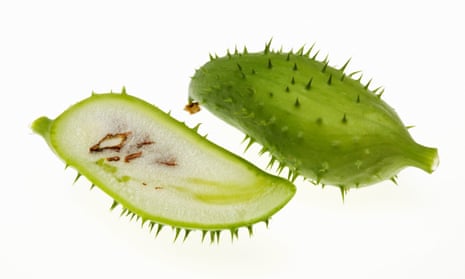Having experimented with hundreds of the more weird and wonderful edible crops over the years, I can personally vouch for the fact that the words “edible” and “tasty” definitely do not always go hand-in-hand, and some delicious crops are impossibly difficult to grow or just have terrible yields. However, every so often there comes along a crop that ticks all the boxes and yet somehow still languishes in the “unusual and oddities” section of seed catalogues.
Probably the best example of this is the achocha, a vigorous and ridiculously easy-to–grow courgette relative from the high Andes. I first ate it while working in Ecuador. The fruit are crisp and watery when raw, much like a cucumber/courgette cross, but really come into their own when fried, sautéed or baked, shrinking down and intensifying in flavour, until they taste almost identical to roast green peppers.
Unlike green peppers, however, if you pick the right variety, they will happily grow outside all over the country. Mates of mine in Sheffield and Edinburgh report similarly staggering yields as those in my Croydon garden, with more than 100 fruit from a single plant. My sad outdoor pepper plants supply a measly three fruit per plant, and no flavour difference from the shop-bought alternative.

If anything, achocha can be a little too rampant, with plants reaching up to 10ft by the end of the summer, so either plant it by a large trellis or an arch for them to scramble over, or be prepared for a little hacking back in midsummer to control their growth. The plants are annuals and will be killed by a hard frost, so there is no danger of them running amok.
I sow mine just as I would regular cucumbers from early March on a sunny windowsill indoors or even directly outside in well-prepared garden beds as late as early May. Being still a relatively new crop in the UK, seeds aren’t stocked by the major catalogues, but are easily found online. The most reliable variety by far is ‘Fat Baby’ whose cute, golf ball-sized fruit are covered in little horns. Don’t worry though, these aren’t sharp, but soft and rubbery in texture and in any case will break down completely when cooked.
For those with a greenhouse, there is also the very rare ‘Giant Bolivian’ variety whose fruit, as the name suggests, are four to five times as long, making them shaped like a pointy cucumber. These hollow, smooth-skinned fruit have the same flavour, but their larger size makes them more popular in the Andes stuffed with cheese and rice or quinoa and baked until golden. Utterly delicious.
In Britain the giant form is sadly lower-yielding outdoors than ‘Fat Baby’, so treat this particular one to a greenhouse if you can. Both varieties are available online from Real Seeds.
Email James at james.wong@observer.co.uk or follow him on Twitter @Botanygeek

Comments (…)
Sign in or create your Guardian account to join the discussion